Crosley CED126SBW, CED126SXQ, CED137HXQ, CED137HXW, CED137SBW Use & Care Guide
...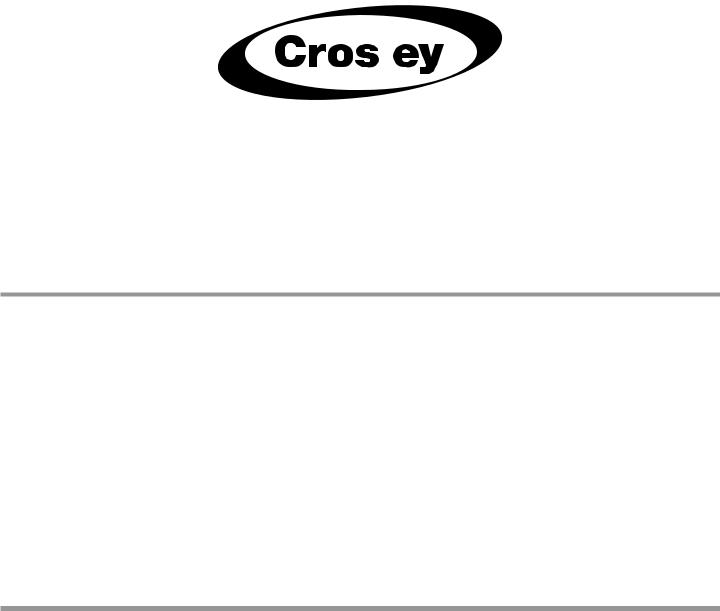
ELECTRIC or GAS DRYER |
|
SÉCHEUSE |
|
||
|
ÉLECTRIQUE ou À GAZ |
|
USE AND CARE GUIDE |
|
GUIDE D’UTILISATION |
|
|
ET D’ENTRETIEN |
|
|
|
|
|
|
Para una versión de estas instrucciones en español, visite www.whirlpool.com
Table of Contents |
|
|
DRYER SAFETY............................................................. |
|
2 |
CHECK YOUR VENT SYSTEM |
|
|
FOR GOOD AIR FLOW.................................................. |
|
4 |
USE SENSOR DRY/AUTO DRY CYCLES FOR |
|
|
BETTER FABRIC CARE AND ENERGY SAVINGS |
.......4 |
|
CONTROL PANEL & FEATURES.................................. |
|
5 |
CYCLE GUIDE................................................................ |
|
6 |
USING YOUR DRYER.................................................... |
|
7 |
DRYER CARE................................................................. |
|
9 |
TROUBLESHOOTING.................................................. |
|
11 |
ACCESSORIES............................................................ |
|
12 |
WARRANTY................................................................. |
|
13 |
ASSISTANCE OR SERVICE..................... |
BACK COVER |
|
Table des matières |
|
SÉCURITÉ DE LA SÉCHEUSE.................................... |
14 |
VÉRIFICATION D’UNE CIRCULATION D’AIR |
|
ADÉQUATE POUR LE SYSTÈME D’ÉVACUATION ... |
16 |
UTILISATION DES PROGRAMMES DE |
|
SÉCHAGE PAR DÉTECTION/AUTOMATIQUE |
|
POUR UN MEILLEUR SOIN DU TISSU ET |
|
DAVANTAGE D’ÉCONOMIES D’ÉNERGIE................. |
16 |
TABLEAU DE COMMANDE |
|
ET CARACTÉRISTIQUES............................................ |
17 |
GUIDE DE PROGRAMMES......................................... |
18 |
UTILISATION DE LA SÉCHEUSE................................ |
19 |
ENTRETIEN DE LA SÉCHEUSE.................................. |
21 |
DÉPANNAGE................................................................ |
24 |
ACCESSOIRES............................................................ |
26 |
GARANTIE.................................................................... |
27 |
ASSISTANCE OU SERVICE..COUVERTURE ARRIÈRE
W10096992A W10097009A - SP
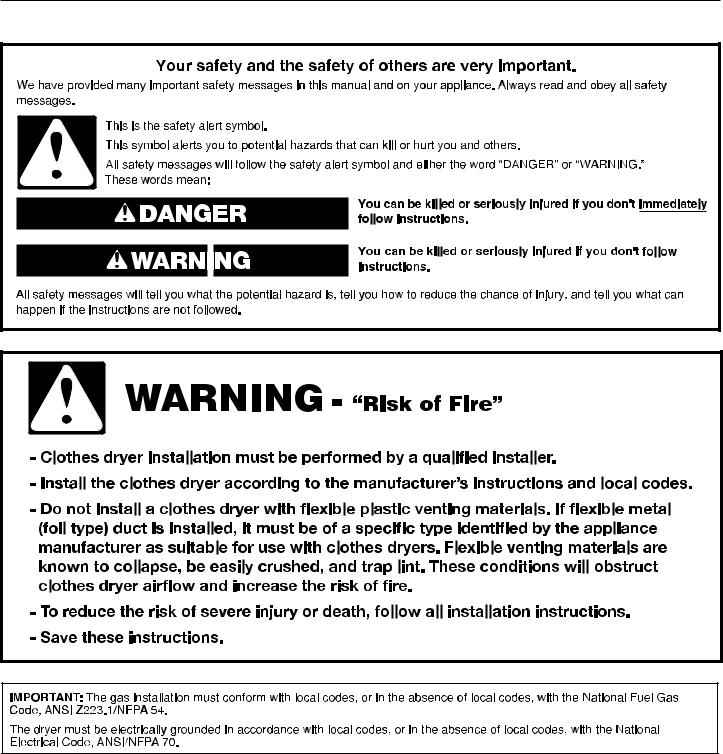
DRYER SAFETY
2
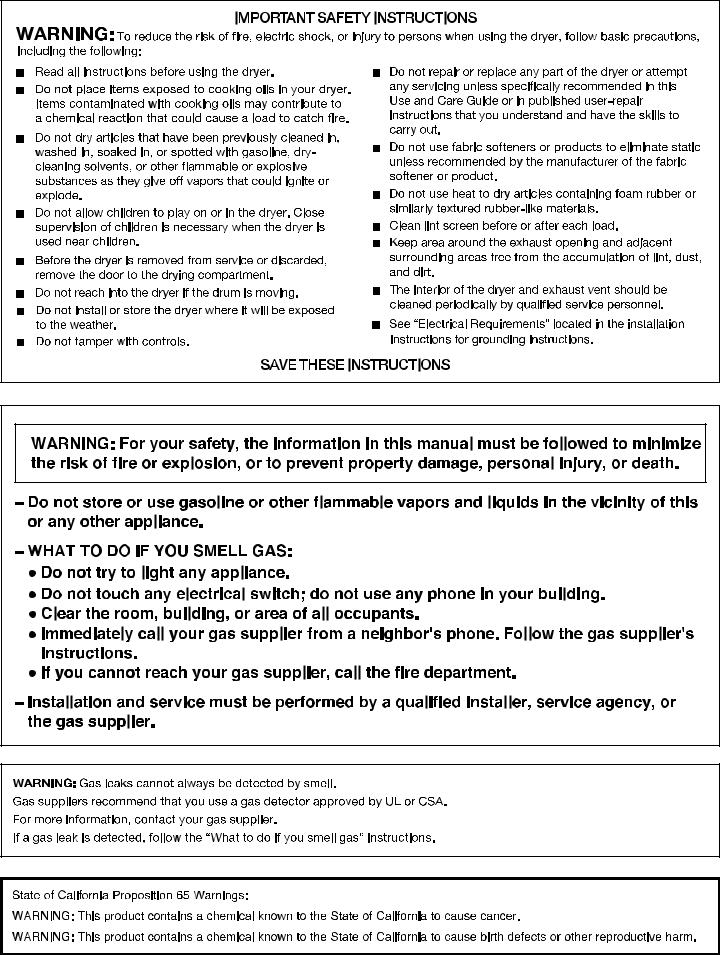
3
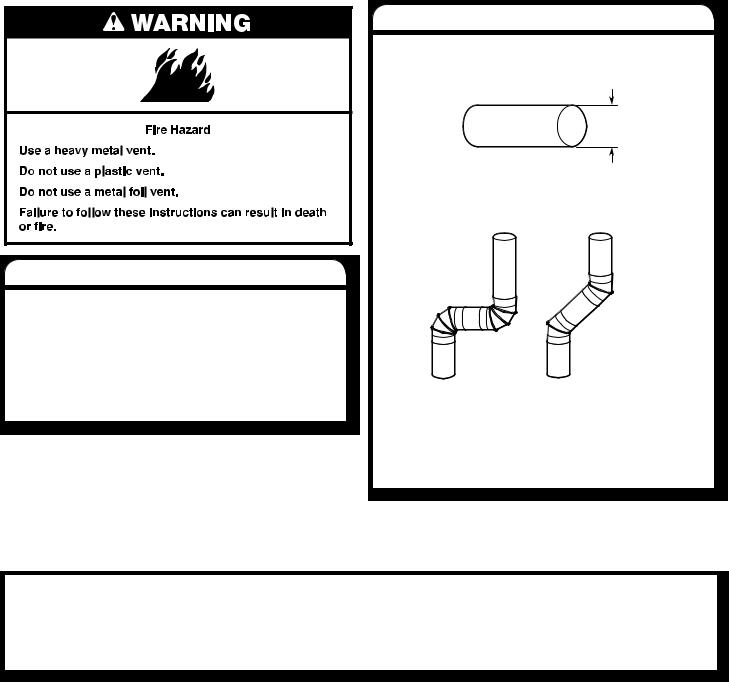
CHECK YOUR VENT SYSTEM FOR GOOD AIR FLOW
Good air flow
Along with heat, dryers require good air flow to efficiently dry laundry. Proper venting will reduce your drying times and improve your energy savings. See “Installation Instructions.”
The venting system attached to the dryer plays a big role in good air flow.
Service calls caused by improper venting are not covered by the warranty and will be paid by the customer, regardless of who installed the dryer.
Maintain good air flow by:
nCleaning your lint screen before each load.
nReplace plastic or foil vent material with 4" (102 mm) diameter heavy, rigid vent material.
4" (102 mm)
nUse the shortest length of vent possible.
nUse no more than four 90° elbows in a vent system; each bend and curve reduces air flow.
Good  Better
Better 
nRemove lint and debris from the exhaust hood.
nRemove lint from the entire length of the vent system at least every 2 years. When cleaning is complete, be sure to follow the “Installation Instructions” supplied with your dryer for final product check.
nClear away items from the front of the dryer.
USE SENSOR DRY/AUTO DRY CYCLES FOR BETTER FABRIC CARE AND ENERGY SAVINGS
Use the Sensor Dry or Auto Dry cycles to provide the most energy savings and enhanced fabric care from the dryer. During Sensor Dry or Auto Dry cycles, drying air temperature or moisture level are sensed in the load. This sensing occurs throughout the drying cycle and the dryer shuts off when the load reaches the selected dryness. The Energy Preferred cycle will provide optimal energy savings.
With Timed Dry, the dryer runs the amount of time set and sometimes results in shrinkage, wrinkling, and static due to over-drying. Use Timed Dry for the occasional damp load that needs a little more drying time or when using the drying rack.
4
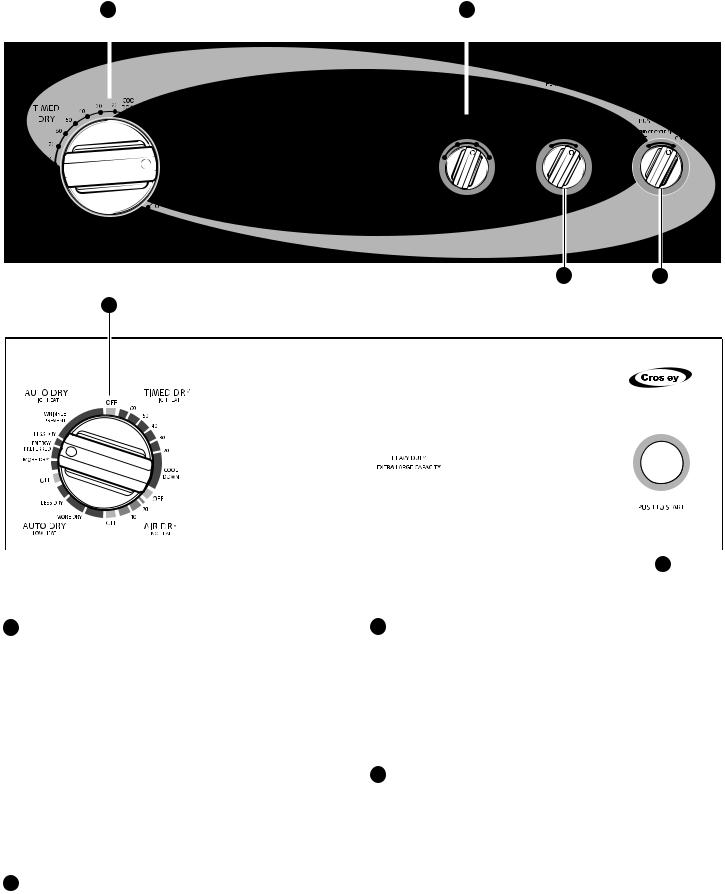
CONTROL PANEL & FEATURES
1 |
2 |
|
|
|||
|
|
|
|
|
|
|
|
|
|
|
|
|
|
|
|
|
|
|
|
|
|
|
|
|
|
|
|
|
|
|
|
|
|
|
|
|
|
|
|
|
|
|
|
|
|
|
|
|
|
|
|
|
|
|
|
|
|
|
|
|
|
|
|
|
|
|
|
|
|
3 |
4 |
1
|
|
|
|
|
|
|
|
|
|
|
|
|
|
|
|
|
|
|
|
|
Not all features and options are available on all models. |
4 |
|
|
||
Appearance may vary. |
|
|
1DRYER CYCLE KNOB
Use your Dryer Cycle Knob to select available cycles on your dryer. Turn the knob to select a cycle for your laundry load. See “Cycle Guide” for detailed descriptions of cycles.
SENSOR DRY/AUTO DRY
Senses moisture in the load or air temperature and shuts off when the load reaches the selected dryness level. Gives the best drying in the shortest time. Drying time will vary based on fabric type, load size, and temperature setting.
Timed Dry
Will run the dryer for the specified time on the control. On models with a selectable temperature knob, you may choose a setting based on the fabrics in your load. On some models, temperature is included in the cycle selections. Drying time and temperature will depend
on your dryer model.
2TEMPERATURE (on some models)
Select a drying temperature based on the fabrics in your load. If you are unsure of the temperature to select for a load, select the lower setting rather than the higher setting.
3WRINKLE PREVENT Feature (on some models)
The WRINKLE PREVENT feature will run after your drying cycle is complete. It periodically starts and stops the dryer, tumbling the load without heat to help avoid wrinkling.
On some models, WRINKLE PREVENT automatically starts at the end of the cycle. Opening the door will stop this feature.
NOTE: A signal will sound periodically when the WRINKLE PREVENT setting is selected, but only if the End of Cycle signal is also selected.
4PUSH TO START/END OF CYCLE SIGNAL
The End of Cycle Signal produces an audible sound when the drying cycle is finished. Promptly removing clothes at the end of the cycle reduces wrinkling.
Turn the END OF CYCLE SIGNAL knob to select the desired setting (On or Off). Press the PUSH to START knob to start the dryer.
5
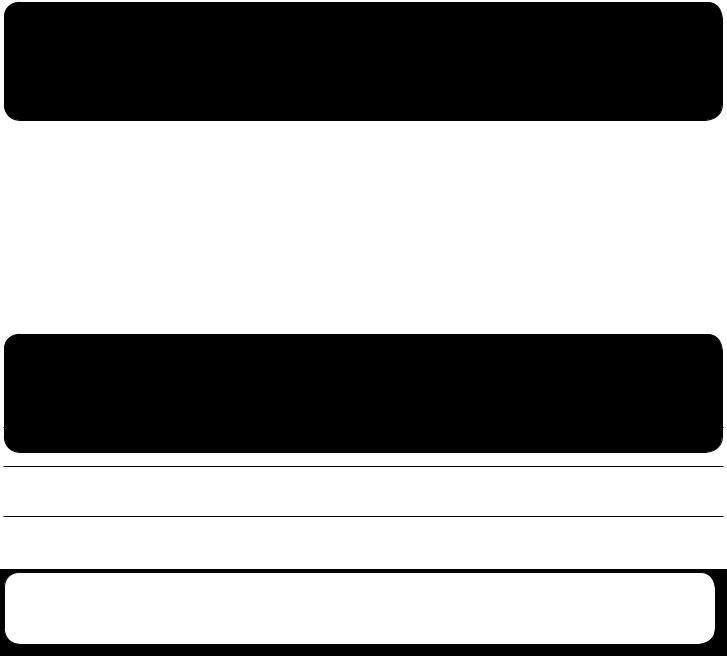
CYCLE GUIDE — SENSOR DRY/AUTO DRY CYCLES
SENSOR DRY/AUTO DRY – Senses moisture in the load or air temperature and shuts off when the load reaches the selected dryness level. Choose ENERGY PREFERRED cycle for optimal energy savings.
Not all cycles and settings are available on all models. Settings and options shown in bold are default settings for that cycle.
Items to dry: |
Dryness Level: |
Temperature: |
Available |
Cycle Details: |
|
|
|
|
Options: |
|
|
|
|
|
|
|
|
Jeans, heavy work |
Heavy Dry |
High |
Wrinkle Prevent |
Automatic cycles give the best drying |
|
clothes, towels |
Very or More Dry |
|
End of Cycle Signal |
in the shortest time. Drying time varies |
|
|
Energy Preferred |
|
based on fabric type, load size, and |
||
|
|
|
|||
|
Less Dry |
|
|
dryness setting. |
|
|
|
|
|
||
|
|
|
|
Select a drying temperature based on |
|
Work clothes, medium |
Heavy Dry |
Medium or Low |
Wrinkle Prevent |
||
weight fabrics, sheets |
Very or More Dry |
|
End of Cycle Signal |
the fabrics in your load. If you are unsure |
|
|
Energy Preferred |
|
of the temperature to select for a load, |
||
|
|
|
|||
|
Less Dry |
|
|
select the lower setting rather than the |
|
|
|
|
|
higher setting. |
|
Casual, shirts, pants, |
Heavy Dry |
Low |
Wrinkle Prevent |
||
|
|||||
lightweight items, |
Very or More Dry |
|
End of Cycle Signal |
|
|
synthetics, delicates, |
Energy Preferred |
|
|
||
|
|
|
|||
athletic wear |
Less Dry |
|
|
|
|
|
|
|
|
||
|
|
|
|
|
NOTE: If loads do not seem as dry as you would like, select Heavy Dry or Very Dry/More Dry next time you dry a similar load. If loads seem drier than you like, select Less Dry next time you dry a similar load.
CYCLE GUIDE — TIMED DRY CYCLES
TIMED DRY – Will run the dryer for the specified time on the control.
Not all cycles and settings are available on all models.
Items to dry: |
Cycle: |
Temperature: |
Available |
Cycle Details: |
|
|
|
Options: |
|
|
|
|
|
|
Large or heavy items |
Heavy Dry |
High |
End of Cycle Signal |
Choose high to dry large or heavy loads. |
such as thick towels or |
|
|
|
|
robes |
|
|
|
|
Heavy or bulky items |
Timed Dry |
High |
End of Cycle Signal |
Completes drying if items are still damp. |
|
High Heat |
|
|
|
Small loads, |
Timed Dry |
Low |
End of Cycle Signal |
Dries items to a damp level or for items |
lightweight items |
|
|
|
that do not require an entire drying |
|
|
|
|
cycle. |
Rubber, plastic, |
Air Dry/ |
Air Only/No Heat |
End of Cycle Signal |
No-heat drying. |
heat-sensitive fabrics |
No Heat |
|
|
|
|
|
|
|
|
Setting the Drying Temperature
|
If your dryer has multiple heat settings: |
Use the Air Dry/No Heat setting for foam, rubber, plastic, |
|
|
A High temperature setting may be used for drying |
or heat-sensitive fabrics. |
|
|
|
|
|
|
heavyweight items such as towels and work clothes. |
Line-dry bonded or laminated fabrics. |
|
|
A Low to Medium temperature setting may be used for |
NOTE: If you have questions about drying temperatures for |
|
|
drying medium-weight items such as sheets, blouses, |
various loads, refer to the care label directions. |
|
|
dresses, underwear, permanent press fabrics, and |
|
|
|
some knits. |
|
|
|
|
|
|
|
|
|
|
6
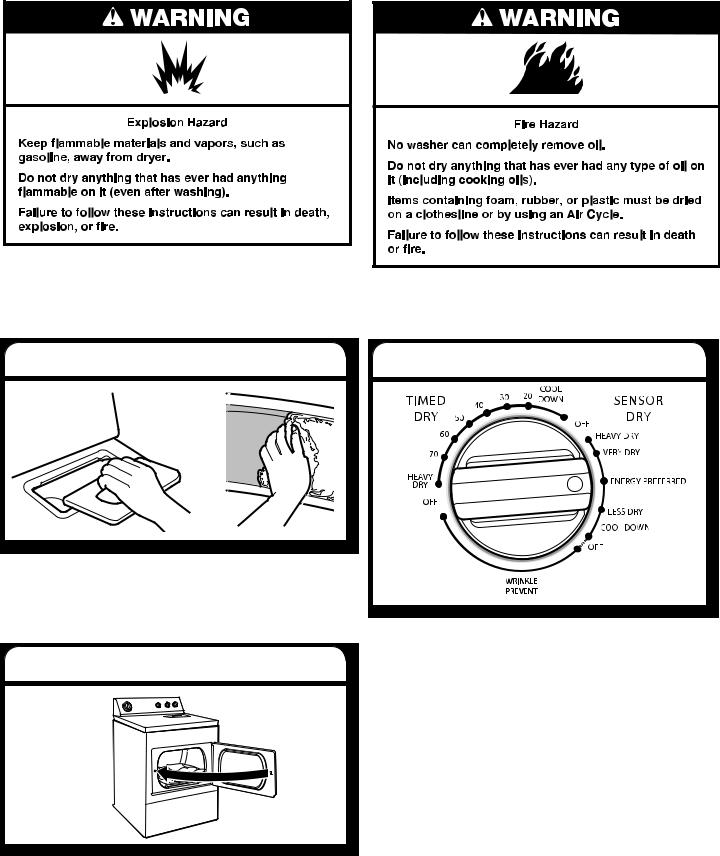
USING YOUR DRYER
WARNING: To reduce the risk of fire, electric shock, or injury to persons, read the “IMPORTANT SAFETY INSTRUCTIONS” before operating this dryer.
Before using your dryer, wipe the dryer drum with a damp cloth to remove dust from storing and shipping.
1. Clean the lint screen
Clean the lint screen before each load. Pull the lint screen out of its holder. Roll lint off the screen with your fingers. Do not rinse or wash screen to remove lint. Push the lint screen firmly back into place.
For additional cleaning information, see “Dryer Care.”
2. Load the dryer
Place laundry in the dryer. Close the door.
NOTE: Your model may have a different door than the one shown. Some models have drop down doors.
Do not tightly pack the dryer; clothes should be able to tumble freely.
3. Select the desired cycle
Select the desired cycle for your load. See the “Cycle Guide” for more information about each cycle.
SENSOR DRY/AUTO DRY Cycles
You can select a different dryness level, depending on your load, by turning the knob to dryness level.
Selecting Heavy Dry, Very Dry/More Dry, ENERGY PREFERRED, or Less Dry automatically adjusts the dryness level at which the dryer will shut off. Once a dry level is set, it cannot be changed without stopping the cycle.
SENSOR DRY/AUTO DRY cycles give the best drying in the shortest time. Drying time varies based on fabric type, load size, and dryness setting.
NOTE: Heavy Dry or Very Dry/More Dry removes more load moisture. ENERGY PREFERRED is used for a starting point for Sensor Dry/Auto Dry cycles. Choose ENERGY PREFERRED for optimal energy savings. Less Dry removes less moisture and is used for loads you may want to put on a hanger to complete drying.
7

4. Set temperature and options (on some models)
6. Press PUSH to START to begin cycle
Select temperature and options by turning the knob to the desired position or select the Automatic Dry Cycle that has the temperature included in the cycle selections.
NOTE: Not all options and settings are available with all cycles.
TEMPERATURE
Turn the TEMPERATURE knob to change the drying temperature setting. See “Setting the Drying Temperature.”
Wrinkle Prevent feature (on some models)
nGet up to 90 minutes of heat-free, periodic tumbling at the end of a cycle. Turn the WRINKLE PREVENT knob to select ON or OFF at any time before the cycle has ended.
5.Select End of Cycle Signal (if desired)
Turn the END OF CYCLE SIGNAL knob to select the desired setting (On or Off). The End of Cycle Signal produces an audible sound when the drying cycle is finished. Promptly removing clothes at the end of the cycle reduces wrinkling.
NOTE: When the Wrinkle Prevent setting is selected and the End of Cycle Signal is on, the tone will sound every 5 minutes until the clothes are removed, or the Wrinkle Prevent setting ends.
Push and hold the PUSH to START knob to begin the cycle.
Promptly remove garments after cycle has completed to reduce wrinkling. Use the Wrinkle Prevent feature to avoid wrinkling when you are unable to remove a load from the dryer as soon as it stops.
Drying Rack (optional on some models)
Use the Drying Rack to dry items such as sweaters and pillows without tumbling. The drum turns, but the drying rack does not move.
If your model does not have a drying rack, you may be able to purchase one for your model. To find out whether your model allows drying rack usage and for information on ordering, please refer to the “Accessories” section
or contact the dealer from whom you purchased your dryer.
NOTE: The drying rack must be removed for normal tumbling.
To use the drying rack
1.Place drying rack in dryer.
Slide rear pegs into the dimples on the back wall of the dryer. Lower the front legs to rest on the dryer opening.
2.Put wet items on top of drying rack, leaving space between items. Do not allow items to hang over the edge of the drying rack. Close the door.
3.Select a Timed Dry cycle and temperature, or an air cycle (on some models). Items containing foam, rubber, or plastic must be dried on a clothesline or by using an air cycle. Refer to the following table.
4.Start the dryer. Reset cycle to complete drying, if needed.
Rack Dry: |
Cycle: |
Temp. |
Time |
|
|
|
|
Washable wool items (block to |
Timed |
Low |
60 min. |
shape, lay flat on drying rack) |
Dry |
|
|
Stuffed toys/pillows (cotton or |
Timed |
Low |
60 min. |
polyester filled) |
Dry |
|
|
Stuffed toys/pillows (foam rubber |
Air |
N/A |
90 min. |
filled) (on some models) |
(no heat) |
|
|
|
|
|
|
8

DRYER CARE
Cleaning the dryer location
Keep dryer area clear and free from items that would block the air flow for proper dryer operation. This includes clearing piles of laundry in front of the dryer.
Cleaning the dryer interior
To clean dryer drum
1.Apply a liquid, nonflammable household cleaner to the stained area of the drum and rub with a soft cloth until stain is removed.
2.Wipe drum thoroughly with a damp cloth.
3.Tumble a load of clean cloths or towels to dry the drum.
NOTE: Garments that contain loose dyes, such as denim blue jeans or brightly colored cotton items, may discolor the dryer interior. These stains are not harmful to your dryer and will not stain future loads of clothes. Dry these items inside out to avoid drum staining.
Removing accumulated lint
From Inside the Dryer Cabinet
Lint should be removed every 2 years, or more often, depending on dryer usage. Cleaning should be done by a qualified servicer.
From the Exhaust Vent
Lint should be removed every 2 years, or more often, depending on dryer usage.
Cleaning the lint screen
Every load cleaning
Clean lint screen before each load. A screen blocked by lint can increase drying time.
To clean:
1.The lint screen is located on top of the dryer. Pull the lint screen out of its holder. Roll lint off the screen with your fingers. Do not rinse or wash screen to remove lint. Wet lint is hard to remove.
2. Push the lint screen firmly back into place.
IMPORTANT:
nDo not run the dryer with the lint screen loose, damaged, blocked, or missing. Doing so can cause overheating and damage to both the dryer and fabrics.
nIf lint falls off the screen into the dryer during removal, check the exhaust hood and remove the lint. The exhaust hood is located where the dryer exhaust exits your home.
As needed cleaning
Laundry detergent and fabric softener residue can build up on the lint screen. This buildup can cause longer drying times for your clothes, or cause the dryer to stop before
your load is completely dry. The screen is probably clogged if lint falls off while the screen is in the dryer.
Clean the lint screen with a nylon brush every 6 months, or more frequently, if it becomes clogged due to a residue buildup.
To wash:
1.Roll lint off the screen with your fingers.
2.Wet both sides of lint screen with hot water.
3.Wet a nylon brush with hot water and liquid detergent. Scrub lint screen with the brush to remove residue buildup.
4.Rinse screen with hot water.
5.Thoroughly dry lint screen with a clean towel. Reinstall screen in dryer.
9
